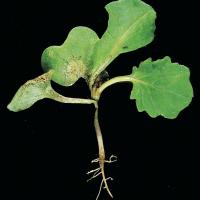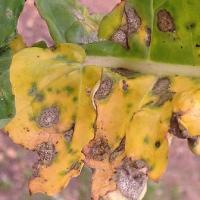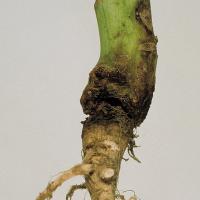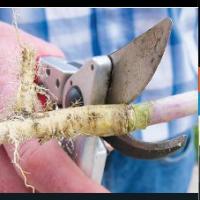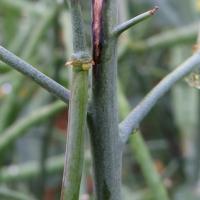Diagnosing blackleg in canola
Blackleg is the most common and serious disease of canola in Western Australia. It is a sexually reproducing fungus that will overcome cultivar resistance genes. While crown canker is the most damaging form, blackleg also causes upper canopy infections (UCI) that may reduce grain yield.
What to look for
- The most obvious symptom is plant death with lodging and premature death after stem extension.
- Plants may be randomly distributed, or more affected in wetter areas, or adjacent to canola stubble.
- From flowering onwards; Stems, branches and pods can develop dark lesions with a pale centre and black fruiting bodies. Flowers, pods or flower spike may abort.
Paddock
- Infection at the seedling stage also causes symptoms (canker) seen at later growth stages.
- Cotyledons develop grey circular spots with pinhead-sized black fruiting bodies then die prematurely.
- Infection spreads through the plant to the hypocotyl which pinches off causing plant death, or ring-barks the stem causing the top to snap off
- Leaves have round to irregular creamish-grey lesions with black fruiting bodies. These also occur on varieties with adult blackleg resistance.
- After stem extension, internal blackening at at the base of the stem causes yield loss without external signs. With very severe infection dark cracked cankers from internal infection cause plants to lodge with premature death and shrivelled seed.
- White or grey, round to linear lesions with black specks and a dark rim may occur on the surface of stems, branches and pods.
- Pale lesions with a purplish rim on petioles cause pod death and may grow into the stem causing a lesion to form there.
Plant
What else could it be
| Condition | Similarities | Differences |
|---|---|---|
| Diagnosing damping off in canola | Sudden seedling death | Blackleg attacks the hypocotyl at ground level, whereas damping off pinches the roots or hypcotyl below ground. Damping off often occurs in patches |
| Diagnosing false wireworm | Sudden seedling death | Chewing damage on stem, petioles, leaves |
| Diagnosing vegetable beetle damage | Sudden seedling death | Chewing damage on stem, petioles, leaves |
| Diagnosing white leaf spot in canola | Greyish leaf lesions | Black lesions contain dark fruiting bodies |
| Diagnosing Group I herbicide damage in canola | Cracked stem canker at ground level after stem extension | The canker is pale not blackened. Above ground plant parts are twisted and distorted. |
|
Cladosporium in canola
|
dark streaking | Blackleg has black specks or fruiting bodies present inside lesion Cladosporium has only been observed after the start of flowering |
Where did it come from?
- Blackleg survives as black fruiting bodies on canola stubble that release large quantities of airborne spores after autumn and winter rainfall
- Within two weeks of spores landing on canola cotyledons and young leaves, clearly visible off-white coloured lesions develop fruiting bodies that release rain-splashed spores.
- Once the lesion has formed, the fungus grows within the plant’s vascular system to the crown where it causes the crown of the plant to rot, and the plant may snap off and die.
- Less severe infection will result in a cracked canker at ground level that restricts water and nutrient flow within the plant, causing it to lodge and mature prematurely.
- Blackleg symptoms have also been found in the plant roots, that causes the entire plant to die prematurely.
Management strategies

Seed dressing fungicide


Resistant varieties
- Foliar fungicide at the 6 leaf stage can slightly reduce loss, but is not generally economic, particularly in the absence of fungicidal seed treatments.
- Fungicide seed treatments are effective but can not totally prevent yield loss.
- Relying only on fungicides to control blackleg poses a high risk of fungicide resistance. Choose a cultivar with adequate blackleg resistance for your region.
- If your monitoring has identified yield loss and you have grown the same cultivar for three years or more, choose a cultivar from a different resistance group.
- Never sow your canola crop into last year’s canola stubble
How can it be monitored?
- As blackleg is capable of overcoming genetic resistance, it is important to monitor crops and manage according to guidelines in the current version of the GRDC blackleg management guide.
- Sample crops annually anytime from the end of flowering to windrowing (swathing).
- Pull 60 randomly chosen stalks out of the ground, cut off the roots with a pair of secateurs and, using the reference photos in the GRDC blackleg management guide, estimate the amount of disease in the stem cross-section. Yield loss occurs when more than half the cross-section is discoloured.
See also
Further information
Where to go for expert help
Page last updated: Monday, 13 June 2022 - 2:18pm


